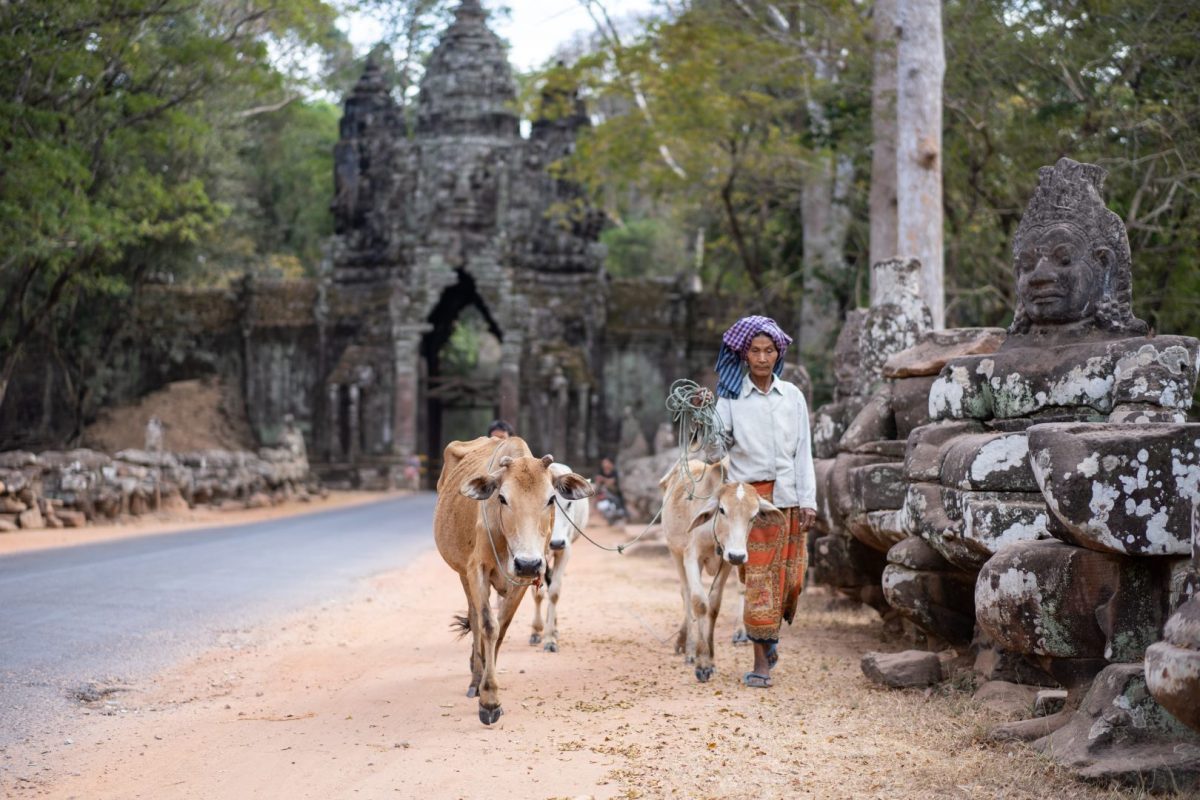Full Day Banteay Srei and Grand Circuit Temples: How to Plan Your Tour in Siem Reap
Are you planning to visit Siem Reap and explore the magnificent temples of Angkor? If so, the Full Day Banteay Srei and Grand Circuit Temples tour is a must-see. This temple-focused itinerary covers a wide range of styles and takes you to some of the most intricate carvings in Angkor that many visitors overlook. In this blog post, we’ll guide you on how to plan your tour and provide all the essential details you need to know.
Overview of the Tour
The Full Day Banteay Srei and Grand Circuit Temples tour is a small-group tour that begins with exploring the highlights of the main site before embarking on a journey into the countryside to visit the Pre Rup Neak Peak Banteay Srei and Preah Khan temples. All transport is by air-conditioned vehicle, making it an ideal way to cool off between temple visits.
This tour is designed for all those visitors who want a deeper understanding and appreciation of Khmer culture, art, and history. You will cover a wide range of temple styles, from the grandest temples to the smallest hidden gems that contain some of Angkor’s most intricate carvings.
Itinerary
The tour itinerary includes the following temples:
Pre Rup Temple
Pre Rup is a Hindu temple located at Angkor, Cambodia. It is a temple mountain of combined brick, laterite, and sandstone construction. The temple’s name is a comparatively modern one, meaning “turn the body.” This reflects the common belief among Cambodians that funerals were conducted at the temple, with the ashes of the body being ritually rotated in different directions as the service progressed.
Neak Pean
Neak Pean is an artificial island with a Buddhist temple in the center of Jayatataka Baray, which was associated with Preah Khan Temple. The island has five square ponds arranged in a quincunx, and the central pond is surrounded by four smaller ponds. Another interpretation holds that the ponds are symbolic of the four elements (earth, water, fire, air), with the center representing the principle of equilibrium.
Banteay Srei Temple
Banteay Srei or Banteay Srey is a 10th-century Cambodian temple dedicated to the Hindu god Shiva. It is built largely of red sandstone, a medium that lends itself to the elaborate decorative wall carvings which are still observable today. The temple’s red sandstone walls are decorated with elaborate carvings designed in miniature, notably of human figures, and these are considered some of the finest examples of classic Khmer art.
Preah Khan Temple
Preah Khan is a temple at Angkor, built in the 12th century for King Jayavarman VII. It is located northeast of Angkor Thom and east of Neak Pean. The temple was built on the site of Jayavarman VI’s capital, and it was reputedly built in honor of his father Dharanindravarman II.
Inclusions and Exclusions
The Full Day Banteay Srei and Grand Circuit Temples tour includes the following:
– Licensed and experienced English Speaking tour guide
– Air-con vehicle
– Hotel pickup and drop off
– Temples entrance fee (37$ – cover all the temples)
– Lunch
The following expenses are not included in the tour:
– Personal expenses
– Other meals and drinks
Meeting and Pickup Details
Pickup and drop off will be at Siem Reap hotels, and the start time of the tour is 08:00 AM.
Booking the Tour
Book the Full Day Banteay Srei and Grand Circuit Temples tour here.
Conclusion
The Full Day Banteay Srei and Grand Circuit Temples tour is the perfect way to explore the art, architecture, and history of Angkor. With the guidance of an experienced tour guide, you will gain a deeper understanding and appreciation of Khmer culture. So, plan your tour now and experience the wonders of Angkor firsthand!
Top Frequently Asked Questions About Siem Reap
Siem Reap is one of the most popular travel destinations in Cambodia. It is the gateway city to Angkor Wat, the largest religious monument in the world, and there are many things to see and do in this charming city. While planning your visit to Siem Reap, you might have some questions in mind. In this blog post, we have put together a list of the most frequently asked questions about Siem Reap to make your travel planning easier.
1. What is the best time to visit Siem Reap?
Siem Reap has a tropical climate, and the best time to visit is during the dry season, which runs from November to March. During these months, you can expect plenty of sunshine and low humidity levels, making it the perfect weather for temple exploring. However, this season is the busiest time, and prices may be higher than usual. If you prefer to avoid the crowds and don’t mind hotter temperatures, you can consider visiting during the shoulder season that runs from April to May or September to October.
2. Do I need a visa to visit Siem Reap?
Yes, you need a visa to visit Cambodia, including Siem Reap. You can either apply for an e-visa online before your arrival or get a visa on arrival at the airport. The cost of the e-visa is USD 36, and you can apply for it online at the official website of the Cambodian Ministry of Foreign Affairs and International Cooperation. If you prefer to get a visa on arrival, the cost is USD 30, and you need to bring a passport-sized photo with you.
3. How do I get around Siem Reap?
There are several ways to get around Siem Reap, including tuk-tuk, bicycle, and car rental. Tuk-tuks are the most popular and affordable option, and you can find them everywhere in the city. The fare for a short ride is around USD 2-3, and you can negotiate with the driver for a full-day tour. If you prefer to explore the city on your own, you can rent a bicycle for around USD 2-3 per day. Car rental is also available, but it is more expensive and not suitable for solo travelers.
4. What temples should I visit in Siem Reap?
Siem Reap is famous for its temples, and the most popular one is Angkor Wat, a UNESCO World Heritage Site. Other temples worth visiting include Bayon, Ta Prohm, Banteay Srei, and Preah Khan. We recommend buying a one-day or three-day temple pass, which costs USD 37 and USD 62, respectively, to explore the temples at your own pace. It is best to visit the temples early in the morning or late in the afternoon to avoid the crowds and the heat.
5. What are some local dishes to try in Siem Reap?
Cambodian cuisine is delicious and diverse, and Siem Reap offers many local dishes to try. Some of the must-try dishes include fish amok, red tree ant fritters, lok lak, and Khmer curry. You can find these dishes at local restaurants and street food stalls all over the city. Don’t forget to try the famous Cambodian coffee and fresh fruit shakes as well.
6. What are some cultural customs to be aware of in Siem Reap?
Cambodian culture is rich and diverse, and while visiting Siem Reap, it is essential to be respectful of the local customs and traditions. Some of the cultural customs to be aware of include removing your shoes when entering temples and private homes, respecting the dress code (covering your shoulders and knees), and avoiding public displays of affection. It is also essential to ask for permission before taking photos of locals or monks.
7. What is the currency used in Siem Reap?
The currency used in Cambodia is the Cambodian riel (KHR), but US dollars are widely accepted in Siem Reap, and it is the preferred currency for most transactions, especially in tourist areas. You can exchange your money at local banks or money exchange kiosks, and ATMs are also widely available throughout the city.
8. What are some safety tips for traveling to Siem Reap?
Siem Reap is a generally safe city, but it is essential to take precautions to ensure a safe trip. Some safety tips to keep in mind include avoiding solo walks late at night or in remote areas, watching your belongings in crowded areas, and not leaving valuables unattended. We recommend booking a reputable tour company or guide for temple exploring, as the temples can be isolated and unsafe for solo travelers.
Conclusion
Siem Reap is a fantastic travel destination with many attractions, cultural experiences, and delicious food to offer. By answering the most frequently asked questions about Siem Reap, we hope we have provided you with some essential information to plan your visit. Always remember to be respectful of the local customs and traditions, take necessary safety precautions, and have a fantastic trip.
Table of Contents

